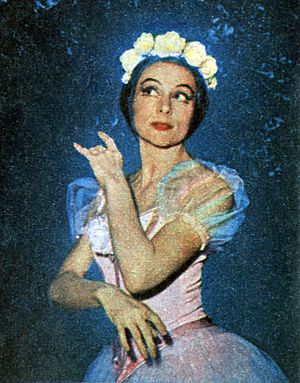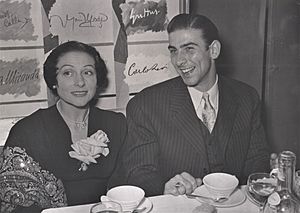Yvette Chauviré facts for kids
Quick facts for kids
Yvette Chauviré
|
|
|---|---|

Yvette Chauviré (1957)
|
|
| Born |
Yvette Adrienne Chauviré
22 April 1917 Paris, France
|
| Died | 19 October 2016 (aged 99) Paris, France
|
| Occupation | Ballet dancer |
| Years active | 1929–1972 |
| Spouse(s) | Constantin Nepokoitchitsky (m. 19??-1976; his death) |
Yvette Chauviré (born April 22, 1917 – died October 19, 2016) was a famous French prima ballerina and actress. Many people called her France's greatest ballerina. She also taught other top dancers like Sylvie Guillem and Marie-Claude Pietragalla. In 1964, she received the Légion d'Honneur, a very important award.
Contents
Early Life of Yvette Chauviré
Yvette Chauviré was born in Paris, France, on April 22, 1917. When she was 10 years old, in 1927, she joined the Paris Opera Ballet school. Just two years later, at age 12, she was noticed for her dancing in a children's ballet. This ballet was called L'Eventail de Jeanne, which means "Jeanne's Fan". By the time she was 13, she was invited to join the main ballet company.
Yvette Chauviré's Ballet Career
Chauviré quickly moved up in the Paris Opera Ballet. She became a principal dancer in 1937. This means she was one of the main dancers. In 1941, she reached the highest rank, called étoile.
She became the star of many new ballets. These were created by the company's director, Serge Lifar. Some of her famous performances included Alexandre le Grand and Suite en Blanc. Lifar also encouraged her to learn from other teachers. These teachers were Boris Kniaseff and Victor Gsovsky. They helped her develop a more graceful and flowing style of dance.
Yvette Chauviré never officially studied with Carlotta Zambelli. However, Chauviré later said she watched Zambelli teach a lot. She learned to copy Zambelli's moves and then made them her own.
In 1945, Serge Lifar had to leave the company. The next year, Chauviré also left. She joined Lifar's new company, the Nouveau Ballet de Monte-Carlo. In 1947, both Lifar and Chauviré came back to the Paris Opera Ballet. But Chauviré left again in 1949. This was because she wanted to dance with other companies too. She performed in many different shows. These included Grand pas classique and La Dame aux camélias.
In 1953, the Paris Opera Ballet allowed her more freedom. She returned to the company. But she also continued to dance as a guest with other groups. She performed in Europe, the United States, South Africa, and Latin America. She often danced with the famous Rudolf Nureyev. He called her a "legend". She also danced with Māris Liepa and Erik Bruhn.
During this time, she performed in more classic ballets. These included Giselle, Sleeping Beauty, and The Nutcracker. The role of Giselle became very special to her. She thought of it as her most important dance.
Chauviré officially retired from the Paris Opera Ballet in 1956. But she still performed with them until 1972. From 1963 to 1968, she also helped lead the Paris Opera Ballet school. She taught future stars like Sylvie Guillem and Marie-Claude Pietragalla. She also created some short ballets herself. In 1970, she became the Director of the International Academy of Dance in Paris.
In an interview in 1989, she talked about modern ballet. She felt it was becoming "more and more slipshod". She also worried that "extreme" ballet moves could hurt dancers. She said that during her career, she tried to make difficult moves look simple.
In 1992, Chauviré was a judge for the first Prix Benois de la Danse competition. This is a big award for dancers.
Books by Yvette Chauviré
Yvette Chauviré wrote two books about her life. In 1960, she published Je suis ballerine. Later, in 1997, she wrote Yvette Chauviré – Autobiographie with Gerard Mannoni.
Yvette Chauviré's Film Roles
In 1937, Chauviré acted in a film called La Mort du Cygne. This means "The Death of the Swan". The movie was about a young girl who wanted to be a ballet dancer. It won a big award at the 1937 Paris Exposition. The film was released in the United States in 1938 as Ballerina. Chauviré became a star in the U.S. and was even on the cover of Life magazine. In 1988, the film was shown again in New York. Chauviré was there to talk about it.
A documentary film was also made about her. It was called Yvette Chauviré: une étoile pour l'example. This film showed her teaching younger ballerinas. It also included old videos of her performances.
Awards and Honours
Yvette Chauviré received many important awards:
- Chevalier of the Legion of Honour in 1964.
- Commander of the Legion of Honour on March 24, 1988.
- Grand Officer of the Legion of Honour on July 13, 2015.
- Commander of the National Order of Merit on June 22, 1994.
- Grand Cross of the National Order of Merit on November 10, 1997.
- Commander of the Order of Arts and Letters.
Personal Life
Yvette Chauviré was married to a Russian artist named Constantin Nepokoitchitsky. He was known as Constantin Nepo. He passed away in 1976. Yvette Chauviré died at her home in Paris on October 19, 2016. She was 99 years old.
Notable Published Works
- Je suis ballerine (1960)
See also
 In Spanish: Yvette Chauviré para niños
In Spanish: Yvette Chauviré para niños


